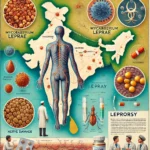The monsoon in India is a critical weather phenomenon that greatly influences the country’s climate, agriculture, water resources, and overall economy. It is characterized by seasonal winds that bring significant rainfall to various parts of the country. Here’s a detailed overview:
Types of Monsoons
- Southwest Monsoon:
- Timing: Typically begins in early June and lasts until September.
- Direction: Winds blow from the southwest towards the northeast.
- Coverage: Affects the entire Indian subcontinent, bringing about 70-90% of the annual rainfall.
- Impact: Crucial for agriculture as it waters over half of India’s farmlands, influencing the sowing of crops such as rice, sugarcane, cotton, and pulses.
- Northeast Monsoon:
- Timing: Occurs from October to December.
- Direction: Winds blow from the northeast towards the southwest.
- Coverage: Primarily affects the southeastern coast of India, including Tamil Nadu, Andhra Pradesh, and parts of Karnataka.
- Impact: Provides necessary rainfall to regions that do not receive sufficient water from the southwest monsoon, aiding the cultivation of crops like rabi and the replenishment of water reservoirs.
- Side Effects of Vitamin D Shots and Their Hidden Link With Blocked Arteries

- AIDS(Acquired Immunodeficiency Syndrome)

- leprosy : Also known as hansen’s disease

Monsoon Onset and Withdrawal
- Onset: The monsoon typically reaches the Kerala coast around June 1st and progresses northwards, covering the entire country by mid-July.
- Withdrawal: The southwest monsoon starts retreating from northwest India by mid-September and completely withdraws from the southern peninsula by mid-October.
Factors Influencing the Monsoon
- El Niño and La Niña: These are climatic phenomena that can significantly impact the intensity and distribution of the monsoon. El Niño generally leads to weaker monsoon rainfall, while La Niña can result in stronger than usual rains.
- Indian Ocean Dipole (IOD): Positive IOD is associated with increased monsoon rains, while a negative IOD tends to reduce rainfall.
Importance of Monsoons
- Agriculture: The monsoon rains are vital for the cultivation of major crops. A good monsoon can lead to bumper harvests, while a weak or delayed monsoon can cause drought and crop failures.
- Water Resources: Monsoon rains replenish rivers, lakes, and groundwater levels, which are essential for drinking water, irrigation, and hydropower generation.
- Economy: A successful monsoon boosts agricultural output, increases rural incomes, and drives demand for goods and services, positively impacting the overall economy.
- Environment: Monsoon rains support biodiversity, forests, and ecosystems, maintaining the ecological balance.
Challenges
- Flooding: Excessive monsoon rains can lead to severe flooding, causing loss of life, property, and crops.
- Drought: Poor monsoon performance can result in drought conditions, water shortages, and agricultural distress.
- Infrastructure: Heavy rains and floods can damage infrastructure, including roads, bridges, and buildings, disrupting daily life and economic activities.
Current Trends and Predictions
The monsoon patterns have shown variability in recent years, with instances of both severe floods and droughts. Climate change is believed to influence these patterns, making monsoon predictions more challenging and necessitating adaptive measures for water management and agriculture.
For more detailed information, you can visit sources like the Indian Meteorological Department and BBC Weather.




